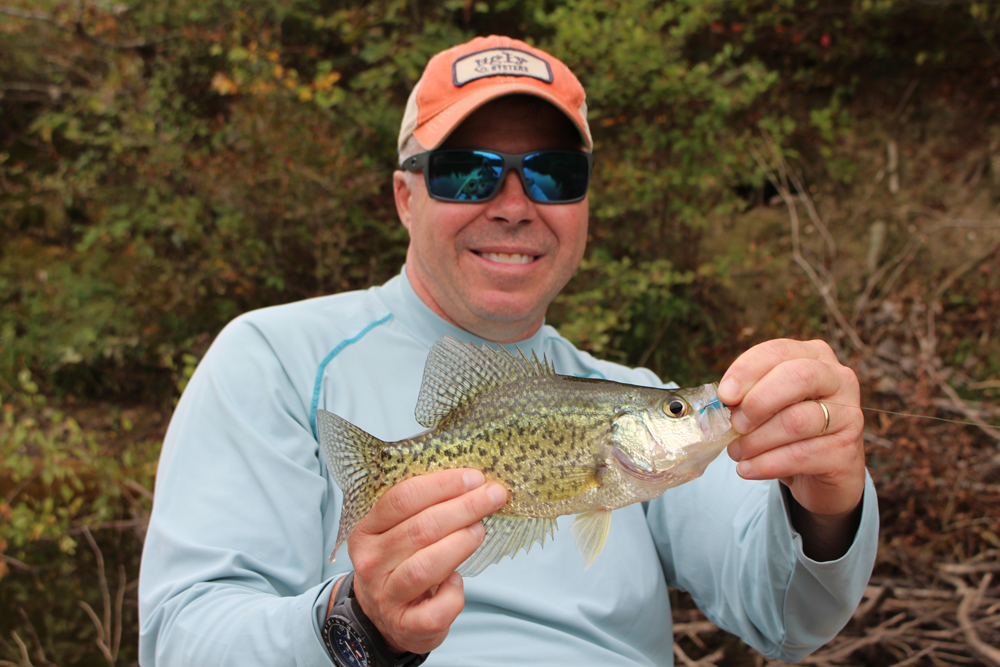You wouldn’t troll in the Chesapeake with the same rod you use for bigeye tuna fishing, and you wouldn’t fish in a stream with the same rod you’d use for tautog fishing, so why do so many anglers crank up panfish on spinning gear intended for much larger prey instead of using ultralight gear? In some cases this is a matter of budgetary constraints, but in many others it’s because people look at fishing for small fish as a secondary concern. That’s a shame, because when fought with the appropriate sized gear panfish put up just as exciting a struggle as other gamefish. And when you land a two-pound perch or a dinnerplate-sized crappie on an ultralight, the adrenalin will pump as hard as it did then you struggled to lift that 40-plus-inch striper over the gunwale. (Well… almost).

On top of the excitement factor, anglers who have ultralight rigs will in certain situations out-catch those casting larger gear by a mile. A wispy-light rod and reel spooled with four- or six-pound line can sling tiny jigs that you can barely cast 10 feet with heavier gear, and you can add 1/8th and even 1/16th of an ounce lures to your arsenal. The short stature of these rigs also gives you an edge when casting out from a shore lined with overhanging trees. And with the enhanced sensitivity of a good ultralight in your hands you’ll be able to feel the gentlest nips and nibbles.
Ultralight Fishing Rods
As is true for most fishing tackle, ultimately your choice will come down to personal taste and your ability to absorb the expense. That said, the usual factors apply, foremost among them action and length. As far as action goes, stick with a fast tip if you mostly plan to sling lures. (This would also be an argument for spooling up your reel with braid as opposed to monofilament, since lightning-fast hook-sets will be in order). If you’re more likely to drift bobbers with bait or live-line minnow with a split-shot, monofilament may be a better match. One note of caution: tying a uni-to-uni to put a mono leader onto a braid mainline can be difficult, with lines this light.
Another note of caution: since increased sensitivity while using light lures and lines is one of the main reasons you’d want to use dedicated ultralight tackle in the first place, it only makes sense to choose a graphite rod. True, they will snap easier than glass rods and yes, those skinny ultralight tips with the diameter of a toothpick are absurdly easy to break. But that’s a cost of doing business, and buying a more rugged rod defeats the purpose.
When it comes to length, longer is definitely not better. Most anglers will be happiest with a rod of no more that six feet and a five-footer is often preferred. Remember that less length does equate to less casting distance, but it’s also easier to control – especially in the very small boats often used for pan-fishing, and around thick overhead shoreline growth.
Ultralight Fishing Reels
There are a lot of extremely cheap ultralight reels out there, and you could get away with spending as little as $20 or $30. Resist the temptation. First off, the few metal parts in these reels will disintegrate into corrosion dust the first time you fish a tidal creek or river with a salt content above zero parts per thousand. Secondly, they tend to have awful drags.

Few things are as important as a silky-smooth drag when it comes to ultralight reels, because of the incredibly light lines you’re using. Four pound test can be used to catch a 10 pound fish if your gear is up to snuff and you play them right. But with a herky-jerky drag you’ll break off almost anything big enough to fillet.
Other Important Ultralight Fishing Gear
A few other items are particularly important to an ultralight angler. Foremost among them is a good landing net. Unlike rigs with heavier lines, you don’t stand much of a chance of swinging in a fish with such light gear. (Warning: trying to swing fish of any size with a graphite ultralight is double-risky, because even the tiniest bit of high-sticking will often result in a broken rod). Remember to get a new with knotless rubber mesh or a rubberized coating if you plan on releasing the catch, to prevent harming the fish. And make sure the handle gives you sufficient reach; just how much you need will depend on whether you fish from a boat, kayak, shore, or all of the above.
Another important tool is a pair of extremely sharp snips, if you plan on using braid line. The microscopic diameter of uber-light braids is such that it will slide between the blades of many snips and scissors.
Finally, consider outfitting yourself with a new tacklebox. Having an ultralight opens up a world of new possibilities as far as lures go, and those little micro-jigs and mini-spinners can easily get lost in the slots and pockets of a big tacklebox that houses all your other gear. Since most of this stuff is tiny you don’t need a large box, but buying one specifically for this type of fishing and keeping it segregated from your other gear makes it much easier to keep track of and access when you’re out on the water.
So – are you ready to battle the biggest bream of the pond in a fair fight? Will you face those powerful pickerel on even terms? Then a dedicated ultralight rig is exactly what you need.
Also See:
Gearing Up, Part II: Choosing The Best Chesapeake Bay Trolling Gear